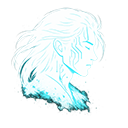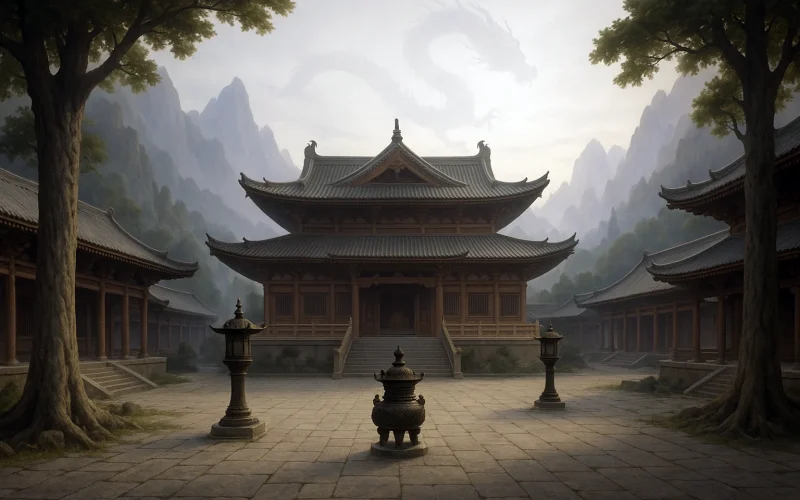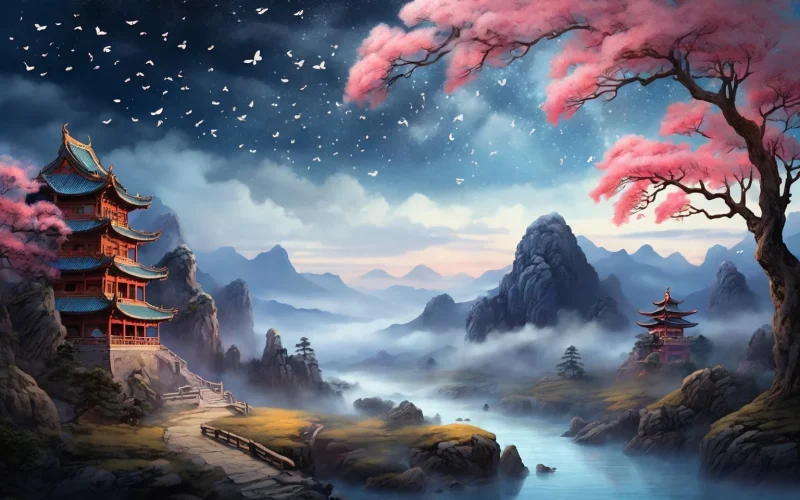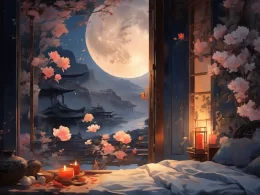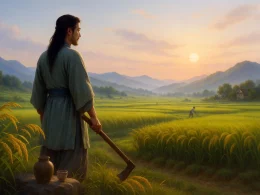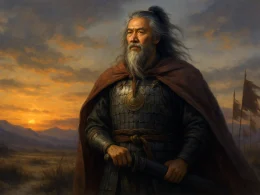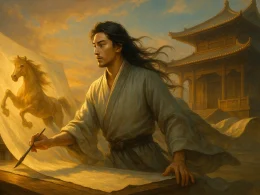The cinnabar peaks coil like lovers’ spines,
This haunted vale in sacred mist entwines.
Halls lurk where cliff-born vapors creep,
Monks sip from veins where stone gods weep.
Serpents and dragons mate in gloom,
Phantoms seal each vaulted room.
Ravines bleed toward altars black,
Mountains kneel where dead trees crack.
Celestial blooms refuse decay,
Moon-milk floods the ghost-road’s way.
This flesh—a sack of sins and woe—
Where shall the damned soul go?
Original Poem
「题栖霞寺」
綦毋潜
南山势回合,灵境依此住。
殿转云崖阴,僧探石泉度。
龙蛇争翕习,神鬼皆密护。
万壑奔道场,群峰向双树。
天花飞不著,水月白成路。
今日观身我,归心复何处。
Interpretation
Composed in 756 CE during the An Lushan Rebellion, this poem emerges from Qiwu Qian’s southern exile to Qixia Temple near Jinling (modern Nanjing). Amidst wartime chaos, the aging poet finds solace in this mountain sanctuary, where Buddhist tranquility contrasts with earthly turmoil. Through layered imagery of sacred geography and cosmic devotion, Qiwu weaves personal refuge with universal Dharma, crafting a meditation on impermanence and the elusive nature of spiritual homecoming.
First Couplet: "南山势回合,灵境依此住。"
Nán shān shì huí hé, líng jìng yī cǐ zhù.
Southern peaks coil like interlocked dragons—
this divine realm rests within their grasp.
The opening lines frame Qixia Mountain as a mandala of spiritual power. "Coil like interlocked dragons" (势回合) evokes both the terrain’s serpentine folds and the protective energy of Buddhist nāgas. By naming the site a "divine realm" (灵境), Qiwu sanctifies it as a bulwark against the rebellion’s devastation, transforming geology into theology.
Second Couplet: "殿转云崖阴,僧探石泉度。"
Diàn zhuǎn yún yá yīn, sēng tàn shí quán dù.
Halls pivot beneath cloud-cloaked cliffs,
monks ford stone springs, probing the way.
Architecture and asceticism merge here. The temple’s "pivoting halls" (殿转) adapt to the mountain’s contours, symbolizing Dharma’s harmony with nature. Monks "probing" (探) springs suggest both literal crossing and spiritual inquiry—their movement a kinetic meditation. The couplet’s interplay of stone and mist, solid and ephemeral, mirrors Buddhism’s middle path.
Third Couplet: "龙蛇争翕习,神鬼皆密护。"
Lóng shé zhēng xī xí, shén guǐ jiē mì hù.
Dragons and serpents duel in swirling breaths,
gods and ghosts conspire in hidden guard.
Qiwu conjures the mountain’s animist aura. "Swirling breaths" (翕习) describe the qi of competing celestial creatures, echoing Esoteric Buddhist cosmology where nāgas and asuras vie for dominion. That both "gods and ghosts" (神鬼) guard the temple underscores its transcendence of dualities—a sanctuary beyond mortal conflicts.
Fourth Couplet: "万壑奔道场,群峰向双树。"
Wàn hè bēn dào chǎng, qún fēng xiàng shuāng shù.
Ten thousand ravines rush toward the altar,
*peaks prostrate before twin *śāla* trees.*
Here, nature itself performs puja. The ravines’ "rushing" (奔) and peaks’ "prostrating" (向) deify the temple’s bodhimaṇḍa (道场). The "twin śāla trees" (双树) reference Buddha’s parinirvana at Kuśinagara, casting Qixia as a site of awakening and dissolution. Landscape becomes liturgy.
Fifth Couplet: "天花飞不著,水月白成路。"
Tiān huā fēi bù zhuó, shuǐ yuè bái chéng lù.
Celestial blossoms flutter but never land,
water-moonlight bleaches a path from void.
Buddhist paradoxes reign. The "unlanding blossoms" (天花飞不著) embody śūnyatā—divine flowers that cannot be grasped, like all phenomena. "Water-moonlight" (水月), a classic metaphor for illusion, paradoxically forms a tangible "path" (路), suggesting enlightenment arises precisely through seeing through delusion.
Sixth Couplet: "今日观身我,归心复何处。"
Jīn rì guān shēn wǒ, guī xīn fù hé chù.
Today, observing this body-self,
where does the homing heart belong?
The finale collapses cosmic visions into human fragility. "Observing this body-self" (观身我) references the Buddhist practice of kāyānupassanā (body contemplation), here tinged with wartime vulnerability. The question "where does the homing heart belong?" (归心复何处) resonates beyond the temple—is "home" a place, a state of mind, or the unconditioned?
Holistic Appreciation
This poem is a masterful fusion of landscape depiction, Buddhist philosophy, and personal reflection. Living in turbulent times, the poet seeks spiritual refuge, finding fleeting tranquility and solace in the secluded forests and pure serenity of Qixia Temple. The verses unfold with undulating imagery and cohesive momentum, portraying the temple as a pure land beyond the mundane world—not only showcasing its solemn beauty but also hinting at the profound mysteries of Buddhist teachings.
The closing couplet connects the poet’s personal state of being with the broader environment, expressing confusion and resignation about life’s direction—a poetic journey that moves from scenery to Zen, from Zen to self-reflection, and from self back to the world. The seamless blend of scene and sentiment gives the poem both aesthetic value and philosophical depth.
Artistic Features
The poem boasts a grand structure and intricate allusions, combining religious imagery with mountain landscapes to create a sacred and transcendent atmosphere. Linguistically, the poet employs abundant Buddhist terminology (e.g., "dharma site," "dharma nature," "heavenly flowers," "twin trees") woven into natural descriptions, intensifying the immersive religious ambiance. Imaginative lines like "heavenly flowers fly but do not land" and "the moonlit water forms a white path" showcase the poet’s fusion of philosophical contemplation and artistic expression.
The style is solemn yet ethereal, exemplifying Qi Wuqian’s signature ability to harmonize landscapes, religion, and existential musings in his poetry.
Insights
Beyond praising the sanctity of Buddhist practice, this poem reflects the struggles of a war-torn scholar searching for spiritual belonging. The question "where does the heart return?" is not just the poet’s personal query but also emblematic of the broader intellectual dilemma of his era—the tension between ideals, faith, and harsh reality.
The poem invites readers to ponder how one finds stability in chaotic times and maintains inner peace amid external turmoil. Through the spiritual realm of Qixia Temple, Qi Wuqian reminds us: a sanctuary for the soul is far more vital than any physical refuge.
About the Poet

Qiwu Qian (綦毋潜 692–c. 755), a native of Ganzhou (modern-day Ganzhou, Jiangxi), was a representative poet of the Landscape and Pastoral School during the High Tang period. He earned the jinshi degree in 726 (the 14th year of the Kaiyuan era) and held official positions such as Right Reminder (You Shiyi) and Editorial Director (Zhuzuo Lang) before retiring to the Jiangnan region. His poetry, renowned for its depictions of reclusive life and natural landscapes, is characterized by a serene and understated style. He exchanged poetic works with Wang Wei, Meng Haoran, and other literary figures. The Complete Tang Poems (Quan Tangshi) preserves 26 of his poems, which stand out distinctly within the High Tang landscape poetry tradition and significantly influenced the development of later Zen-inspired poetry.

